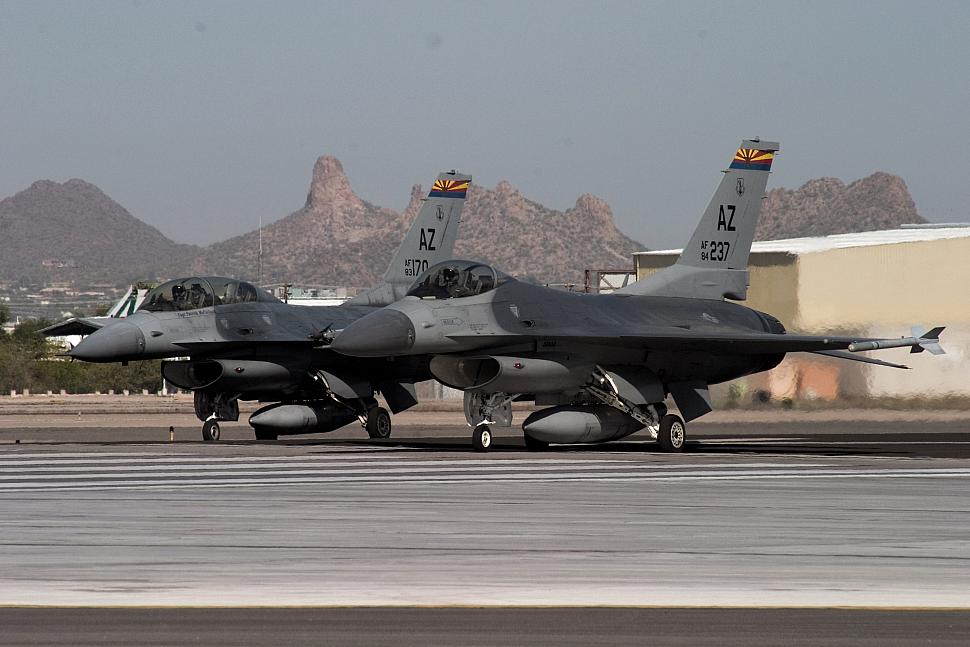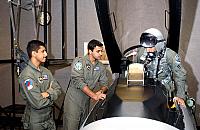Fighter Jet News
F-16 Fighting Falcon News
Building capable allies, strong bonds
August 14, 2008 (by
Capt. Gabe Johnson) -
Over European castles, Middle Eastern deserts and Pacific islands, F-16 Fighting Falcon pilots are soaring in ever-increasing numbers.
Their landscapes, nationalities and cultures are different, but they share several common bonds. They are allies, they are friends and they learned to fly their F-16s at an Air National Guard base in Arizona.
With more nations adding the F-16 to their fighter inventories, the need for pilot training increases, and air force pilots from all over the world are traveling to the Arizona Air National Guard's 162nd Fighter Wing at Tucson International Airport to learn how to fly the multipurpose fighter.
"Our primary goal for international pilot training is to build a foundation that will enable us all to carry out operations as coalition partners," said Brig. Gen. Rick Moisio, the 162nd FW commander. "And this wing has the people, equipment and experience to do just that."
Roughly 1,600 Arizona Air National Guardsmen at Tucson International Airport maintain and operate 70 F-16s for the purpose of training student fighter pilots from current partners Poland, Singapore, Norway, Denmark, Bahrain and the United Arab Emirates.
"Over the last 19 years, the wing has trained more than 750 pilots from 23 of the 24 nations that fly the F-16. It's a mission we know very well," said General Moisio. "Enhancing the air capabilities of other nations is what we do; and as senior leaders often point out, it's an undertaking of the utmost significance in our post Cold War environment."
From the highest levels of the Department of Defense, leaders are directing efforts to develop the air forces of partner nations.
Defense Secretary Robert Gates emphasized the importance of international training to Air Force leaders April 21 during a speech he gave to the Air War College at Maxwell Air Force Base, Ala.
"What the last 25 years have shown is that the threats can emerge almost anywhere in the world, but our own forces and resources will remain finite," said the secretary. "To fill this gap, we must help our allies and partners to confront extremists and other potential sources of global instability within their borders."
To advance the initiative, 162nd FW instructors train more than 70 international student pilots per year, offering several training programs that range from initial F-16 training to qualify new pilots to an advanced weapons course.
The initial training course, for example, is six-to-eight months in duration and carries the largest number of students.
"By the time an initial student pilot arrives in Tucson, he already has his pilot wings and he's graduated from the Defense Language Institute so we can be sure he knows how to fly and how to communicate in English," said Col. Randy Straka, an instructor pilot and the unit's operations group commander. "Our job is to start the student out in the F-16 from square one."
Colonel Straka has 13 years of experience training foreign military students, and attributes the wing's training success to several factors.
"First and foremost, the 162nd has a tremendous safety record because our maintenance personnel here average 18 years of experience specializing on the F-16," said the colonel. "That instills confidence in the nations we train."
Adding to the secure feeling of flying aircraft from one of the safest F-16 fleets in the world is the freedom afforded by Arizona's plentiful ranges.
"We consider our ranges to be national treasures," Colonel Straka said. "There are very few places in the world with this kind of airspace for military training."
The Barry Goldwater range in southwest Arizona, the state's largest, consists of 2.7 million acres of relatively undisturbed Sonoran Desert. Overhead are 57,000 cubic miles of airspace where fighter pilots can practice air-to-air maneuvers and engage simulated battlefield targets on the ground.
"Finally, we average 17,000 flying hours per year, and we're able to do that because of Arizona's year-round good weather. Less than 3 percent of scheduled sorties here are canceled due to weather... that's practically unheard of in other parts of the world" said the colonel.
All of these elements add up to optimal flight-training conditions which allow the wing's cadre of 72 instructor pilots to execute an aggressive training schedule.
"The students get the best possible flight education when they come here," said General Moisio. "Our pilots average 10 years of instructor time and 2,300 flying hours in the F-16."
The United States will always have the world's best fighter pilots, said the general, but it's the 162nd's duty to strengthen the capabilities of our nation's allies.
"On its most basic level, it's about flying together, operating together and training together, so if we have to, we can fight together," General Moisio said. "On a deeper level, it's about friendships. With more than 4,000 F-16s in operation around the world, creating the foundation of a relationship is absolutely invaluable."
With more nations adding the F-16 to their fighter inventories, the need for pilot training increases, and air force pilots from all over the world are traveling to the Arizona Air National Guard's 162nd Fighter Wing at Tucson International Airport to learn how to fly the multipurpose fighter.
"Our primary goal for international pilot training is to build a foundation that will enable us all to carry out operations as coalition partners," said Brig. Gen. Rick Moisio, the 162nd FW commander. "And this wing has the people, equipment and experience to do just that."
Roughly 1,600 Arizona Air National Guardsmen at Tucson International Airport maintain and operate 70 F-16s for the purpose of training student fighter pilots from current partners Poland, Singapore, Norway, Denmark, Bahrain and the United Arab Emirates.
"Over the last 19 years, the wing has trained more than 750 pilots from 23 of the 24 nations that fly the F-16. It's a mission we know very well," said General Moisio. "Enhancing the air capabilities of other nations is what we do; and as senior leaders often point out, it's an undertaking of the utmost significance in our post Cold War environment."
From the highest levels of the Department of Defense, leaders are directing efforts to develop the air forces of partner nations.
Defense Secretary Robert Gates emphasized the importance of international training to Air Force leaders April 21 during a speech he gave to the Air War College at Maxwell Air Force Base, Ala.
"What the last 25 years have shown is that the threats can emerge almost anywhere in the world, but our own forces and resources will remain finite," said the secretary. "To fill this gap, we must help our allies and partners to confront extremists and other potential sources of global instability within their borders."
To advance the initiative, 162nd FW instructors train more than 70 international student pilots per year, offering several training programs that range from initial F-16 training to qualify new pilots to an advanced weapons course.
The initial training course, for example, is six-to-eight months in duration and carries the largest number of students.
"By the time an initial student pilot arrives in Tucson, he already has his pilot wings and he's graduated from the Defense Language Institute so we can be sure he knows how to fly and how to communicate in English," said Col. Randy Straka, an instructor pilot and the unit's operations group commander. "Our job is to start the student out in the F-16 from square one."
Colonel Straka has 13 years of experience training foreign military students, and attributes the wing's training success to several factors.
"First and foremost, the 162nd has a tremendous safety record because our maintenance personnel here average 18 years of experience specializing on the F-16," said the colonel. "That instills confidence in the nations we train."
Adding to the secure feeling of flying aircraft from one of the safest F-16 fleets in the world is the freedom afforded by Arizona's plentiful ranges.
"We consider our ranges to be national treasures," Colonel Straka said. "There are very few places in the world with this kind of airspace for military training."
The Barry Goldwater range in southwest Arizona, the state's largest, consists of 2.7 million acres of relatively undisturbed Sonoran Desert. Overhead are 57,000 cubic miles of airspace where fighter pilots can practice air-to-air maneuvers and engage simulated battlefield targets on the ground.
"Finally, we average 17,000 flying hours per year, and we're able to do that because of Arizona's year-round good weather. Less than 3 percent of scheduled sorties here are canceled due to weather... that's practically unheard of in other parts of the world" said the colonel.
All of these elements add up to optimal flight-training conditions which allow the wing's cadre of 72 instructor pilots to execute an aggressive training schedule.
"The students get the best possible flight education when they come here," said General Moisio. "Our pilots average 10 years of instructor time and 2,300 flying hours in the F-16."
The United States will always have the world's best fighter pilots, said the general, but it's the 162nd's duty to strengthen the capabilities of our nation's allies.
"On its most basic level, it's about flying together, operating together and training together, so if we have to, we can fight together," General Moisio said. "On a deeper level, it's about friendships. With more than 4,000 F-16s in operation around the world, creating the foundation of a relationship is absolutely invaluable."
Courtesy of 162nd Fighter Wing Public Affairs
Additional images:
Related articles:
Forum discussion:
Tags
- UAE seeks F-16 pilot training in the USA (2007-06-27)
- Singapore to continue pilot training program in the US (2006-08-03)
- First Polish pilot qualified on the F-16 (2005-11-15)
- Exchange program connects U.S., Dutch Airmen (2005-08-26)
- F-16 Fighting Falcon news archive
Forum discussion:
- Start a discussion about this article in the F-16.net forum.
Tags


